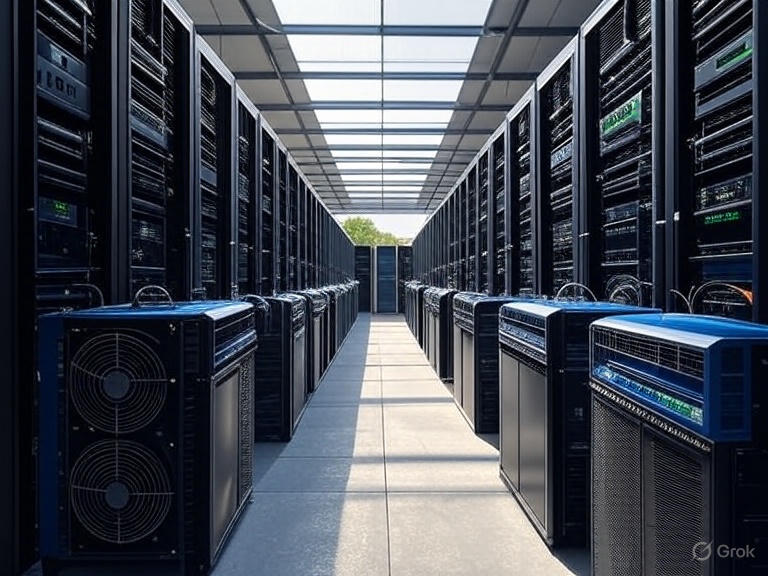The Energy That Powers Giants Like Chat GPT
This article delves into the energy use of LLMs like ChatGPT, covering training and inference, environmental impact, and mitigation strategies for sustainable AI.
AI FOR TECH MINDED
Robin Lamott
8/3/20256 min read
Introduction
Large language models (LLMs) like ChatGPT, developed by OpenAI, have transformed how we interact with technology, enabling sophisticated text generation, translation, and problem-solving. However, their computational demands raise significant questions about energy consumption and environmental impact. This article explores the energy usage of LLMs, delving into the factors influencing their energy demands, the environmental implications, and efforts to mitigate their carbon footprint. By examining training, inference, and operational phases, we aim to provide a comprehensive understanding of the energy dynamics of these AI giants.
The Scale of Large Language Models
LLMs like ChatGPT are built on complex architectures, such as the GPT (Generative Pre-trained Transformer) series, which rely on billions of parameters to process and generate human-like text. For context, GPT-3, a predecessor to ChatGPT, has 175 billion parameters, requiring immense computational resources to train and deploy. The scale of these models directly correlates with their energy consumption, as larger models demand more processing power, memory, and data transfer.
The energy use of LLMs can be broken into two primary phases: training and inference. Training involves teaching the model to understand and generate text by processing vast datasets, while inference refers to the model's operation when responding to user queries. Both phases consume significant energy, but their patterns and impacts differ.
Energy Consumption During Training
The Training Process
Training an LLM is a computationally intensive process that involves feeding massive datasets through neural networks to optimize parameters. This requires high-performance hardware, typically Graphics Processing Units (GPUs) or Tensor Processing Units (TPUs), running for days or weeks in data centers. The energy consumed depends on several factors:
Model Size: Larger models with more parameters require more computations. For example, training GPT-3 is estimated to have required millions of GPU-hours.
Dataset Size: LLMs are trained on datasets containing terabytes of text, such as web crawls or books, necessitating extensive data processing.
Hardware Efficiency: The type and efficiency of hardware (e.g., NVIDIA A100 GPUs vs. older models) impact energy use.
Training Duration: Training can take weeks or months, with continuous power draw.
Estimating Training Energy
Precise energy estimates for models like ChatGPT are scarce, as companies like OpenAI do not publicly disclose detailed figures. However, studies on similar models provide insights. A 2019 study estimated that training a transformer model with 6 billion parameters consumed approximately 626,000 kWh, equivalent to the annual energy use of about 60 U.S. households. GPT-3, with 175 billion parameters, likely consumed significantly more—potentially in the range of several gigawatt-hours (GWh).
To put this in perspective, training a single large model can emit as much carbon dioxide (CO₂) as several transatlantic flights. A 2020 analysis by the University of Massachusetts estimated that training a model like BERT (a smaller predecessor to GPT-3) produced about 652 kg of CO₂, comparable to a round-trip flight between New York and San Francisco per passenger.
Factors Influencing Training Energy
Several factors amplify or mitigate energy use during training:
Data Center Efficiency: Data centers with advanced cooling systems and renewable energy sources reduce environmental impact.
Hardware Optimization: Newer GPUs, like NVIDIA’s H100, are more energy-efficient than older models, reducing power per computation.
Algorithmic Efficiency: Techniques like mixed-precision training or sparsity can lower energy demands by reducing computational complexity.
Energy Consumption During Inference
What is Inference?
Inference occurs when a trained LLM processes user inputs to generate responses. For ChatGPT, this happens every time a user asks a question or requests text generation. Unlike training, which is a one-time process, inference is ongoing, as models serve millions of users daily. Consequently, inference can dominate the energy footprint of LLMs over time, especially for popular models like ChatGPT.
Estimating Inference Energy
Inference energy depends on the frequency of queries, the complexity of responses, and the hardware used. A single inference pass (e.g., generating a response to a query) consumes less energy than training but accumulates significantly due to high usage volumes. For instance, if ChatGPT processes millions of queries daily, even small per-query energy costs add up.
A 2021 study estimated that inference for a model like BERT consumes about 0.1–1 Wh per query, depending on the task and hardware. For a model like ChatGPT, which is larger and handles more complex tasks, the energy per query might be higher, potentially 1–10 Wh. If ChatGPT handles 10 million queries daily, this translates to 10–100 MWh per day, equivalent to the daily energy use of thousands of households.
Factors Influencing Inference Energy
Query Volume: High-traffic models like ChatGPT face greater energy demands.
Response Complexity: Generating long or intricate responses requires more computations.
Hardware Scaling: Data centers scale resources dynamically, but inefficient scaling can lead to energy waste.
User Behavior: Frequent or redundant queries increase energy use.
Environmental Impact
Carbon Footprint
The energy consumption of LLMs translates into a significant carbon footprint, particularly when powered by fossil fuel-based grids. For example, if a data center relies on coal or natural gas, the CO₂ emissions from training and inference are substantial. A 2020 study estimated that training a large NLP model could emit 5–10 tons of CO₂, depending on the energy mix.
Inference, due to its continuous nature, can surpass training emissions over time. For a model like ChatGPT, serving billions of queries annually could result in emissions equivalent to thousands of tons of CO₂, comparable to the annual output of a small factory.
Regional Variations
The environmental impact varies by region due to differences in energy grids. Data centers in countries with renewable-heavy grids (e.g., Iceland or Sweden) have lower emissions than those in coal-dependent regions (e.g., parts of China or India). Major AI providers like OpenAI, Google, and Microsoft often operate data centers in regions with access to renewable energy, but the global distribution of servers means fossil fuels still play a role.
Mitigating Energy Consumption
Advances in Hardware
Hardware improvements are a key strategy for reducing LLM energy use. Newer GPUs and TPUs are designed for higher performance per watt. For example, NVIDIA’s A100 GPUs are up to 20 times more efficient than older models like the V100. Custom AI chips, such as Google’s TPUs or Amazon’s Inferentia, further optimize energy use for specific tasks.
Algorithmic Improvements
Researchers are developing techniques to make LLMs more energy-efficient:
Model Compression: Techniques like quantization and pruning reduce model size without significant performance loss.
Efficient Architectures: Models like DistilBERT or TinyML use fewer parameters while maintaining accuracy.
Sparse Training: Activating only a subset of parameters during training or inference lowers energy demands.
Renewable Energy Adoption
Many tech giants, including OpenAI’s partners like Microsoft, are investing in renewable energy for data centers. Microsoft’s goal to be carbon-negative by 2030 includes powering AI workloads with renewables. However, the transition is incomplete, and some data centers still rely on fossil fuels.
Carbon Offsetting
Some companies offset their emissions by purchasing carbon credits or investing in reforestation and renewable projects. While this doesn’t reduce energy consumption, it mitigates environmental impact. Critics argue that offsetting is less effective than direct energy reductions.
Comparing LLMs to Other Technologies
To contextualize LLM energy use, consider comparisons with other technologies:
Cryptocurrency Mining: Bitcoin mining consumes an estimated 100–200 TWh annually, dwarfing the energy use of LLMs. However, LLMs’ localized, high-intensity energy demands can strain data center resources.
Cloud Computing: General cloud services, like video streaming or web hosting, consume vast energy but are distributed across diverse workloads. LLMs, while energy-intensive, are a subset of cloud computing.
Household Appliances: The energy to train one LLM could power a U.S. household for years, but inference energy is more comparable to daily appliance use when spread across millions of queries.
Challenges and Trade-offs
Reducing LLM energy consumption involves trade-offs. Smaller models or reduced training may lower energy use but compromise performance. Similarly, prioritizing renewable energy increases costs, which may affect accessibility. Balancing performance, cost, and sustainability is a key challenge for AI developers.
Future Directions
Research and Development
Ongoing research aims to create energy-efficient AI. Initiatives like the Green AI movement advocate for sustainable practices, emphasizing metrics like energy per computation alongside accuracy.
Policy and Regulation
Governments and organizations are beginning to address AI’s environmental impact. The European Union’s AI Act and similar frameworks may impose energy efficiency standards for AI systems, encouraging greener practices.
Transparency
Greater transparency from AI providers about energy consumption and emissions would enable better assessment and mitigation strategies. Currently, limited public data hinders precise analysis.
Conclusion
The energy consumption of giants like ChatGPT is substantial, driven by the computational demands of training and inference. While training consumes gigawatt-hours for a single model, inference can accumulate even greater energy use over time due to high query volumes. The environmental impact, particularly CO₂ emissions, depends on the energy mix of data centers and the efficiency of hardware and algorithms. Efforts to mitigate this include hardware advancements, algorithmic optimizations, and renewable energy adoption, but challenges remain in balancing performance and sustainability. As LLMs become integral to technology, understanding and addressing their energy footprint is crucial for a sustainable AI future.


© 2025. All rights reserved.

